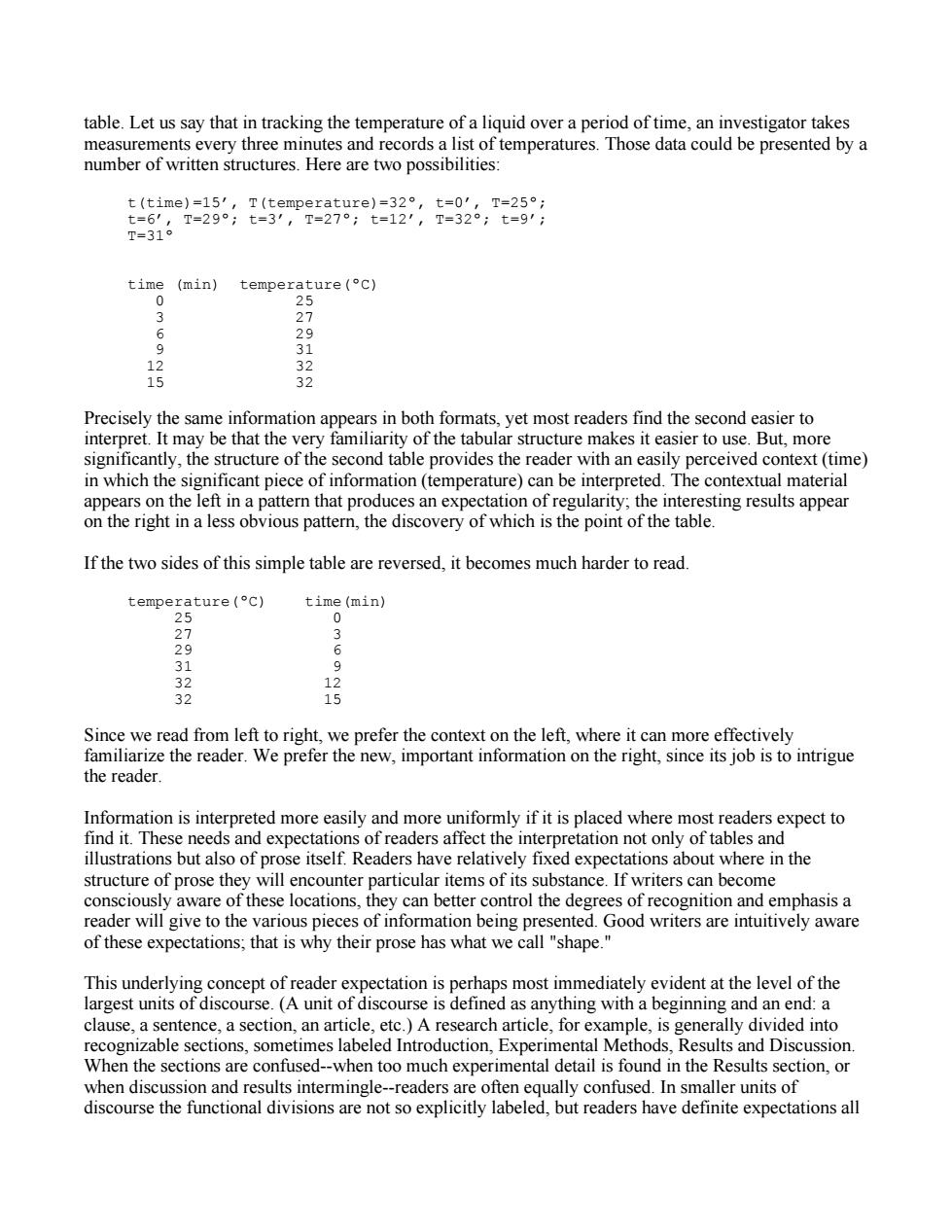正在加载图片...

table.Let us say that in tracking the temperature of a liquid over a period of time,an investigator takes measurements every three minutes and records a list of temperatures.Those data could be presented by a number of written structures.Here are two possibilities: t(time)=15',T(temperature)=32°,t=0',T=25°; t=6',T=29°;t=3',T=27°;t=12',T=32°;t=9'; T=31° time (min) temperature(°c) 0 25 3 27 6 29 9 31 32 15 32 Precisely the same information appears in both formats,yet most readers find the second easier to interpret.It may be that the very familiarity of the tabular structure makes it easier to use.But,more significantly,the structure of the second table provides the reader with an easily perceived context(time) in which the significant piece of information(temperature)can be interpreted.The contextual material appears on the left in a pattern that produces an expectation of regularity;the interesting results appear on the right in a less obvious pattern,the discovery of which is the point of the table. If the two sides of this simple table are reversed,it becomes much harder to read. temperature(°c) time (min) 25 0 27 3 29 6 31 9 32 12 32 15 Since we read from left to right,we prefer the context on the left,where it can more effectively familiarize the reader.We prefer the new,important information on the right,since its job is to intrigue the reader. Information is interpreted more easily and more uniformly if it is placed where most readers expect to find it.These needs and expectations of readers affect the interpretation not only of tables and illustrations but also of prose itself.Readers have relatively fixed expectations about where in the structure of prose they will encounter particular items of its substance.If writers can become consciously aware of these locations,they can better control the degrees of recognition and emphasis a reader will give to the various pieces of information being presented.Good writers are intuitively aware of these expectations;that is why their prose has what we call "shape." This underlying concept of reader expectation is perhaps most immediately evident at the level of the largest units of discourse.(A unit of discourse is defined as anything with a beginning and an end:a clause,a sentence,a section,an article,etc.)A research article,for example,is generally divided into recognizable sections,sometimes labeled Introduction,Experimental Methods,Results and Discussion. When the sections are confused--when too much experimental detail is found in the Results section,or when discussion and results intermingle--readers are often equally confused.In smaller units of discourse the functional divisions are not so explicitly labeled,but readers have definite expectations alltable. Let us say that in tracking the temperature of a liquid over a period of time, an investigator takes measurements every three minutes and records a list of temperatures. Those data could be presented by a number of written structures. Here are two possibilities: t(time)=15’, T(temperature)=32º, t=0’, T=25º; t=6’, T=29º; t=3’, T=27º; t=12’, T=32º; t=9’; T=31º time (min) temperature(ºC) 0 25 3 27 6 29 9 31 12 32 15 32 Precisely the same information appears in both formats, yet most readers find the second easier to interpret. It may be that the very familiarity of the tabular structure makes it easier to use. But, more significantly, the structure of the second table provides the reader with an easily perceived context (time) in which the significant piece of information (temperature) can be interpreted. The contextual material appears on the left in a pattern that produces an expectation of regularity; the interesting results appear on the right in a less obvious pattern, the discovery of which is the point of the table. If the two sides of this simple table are reversed, it becomes much harder to read. temperature(ºC) time(min) 25 0 27 3 29 6 31 9 32 12 32 15 Since we read from left to right, we prefer the context on the left, where it can more effectively familiarize the reader. We prefer the new, important information on the right, since its job is to intrigue the reader. Information is interpreted more easily and more uniformly if it is placed where most readers expect to find it. These needs and expectations of readers affect the interpretation not only of tables and illustrations but also of prose itself. Readers have relatively fixed expectations about where in the structure of prose they will encounter particular items of its substance. If writers can become consciously aware of these locations, they can better control the degrees of recognition and emphasis a reader will give to the various pieces of information being presented. Good writers are intuitively aware of these expectations; that is why their prose has what we call "shape." This underlying concept of reader expectation is perhaps most immediately evident at the level of the largest units of discourse. (A unit of discourse is defined as anything with a beginning and an end: a clause, a sentence, a section, an article, etc.) A research article, for example, is generally divided into recognizable sections, sometimes labeled Introduction, Experimental Methods, Results and Discussion. When the sections are confused--when too much experimental detail is found in the Results section, or when discussion and results intermingle--readers are often equally confused. In smaller units of discourse the functional divisions are not so explicitly labeled, but readers have definite expectations all